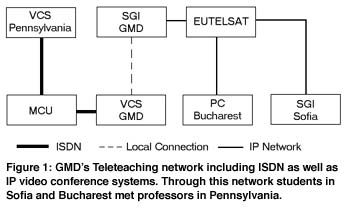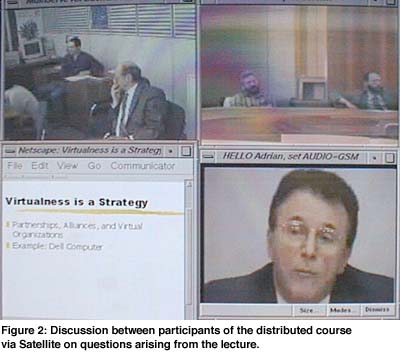Live Teleteaching via the Internet
by Konstantinos Fostiropoulos, Detlef Skaley, Hideyuki Inamura and Sepideh Chakaveh
The telecommunication sector for scientific use has developed
parallel to the classical telephone system. However, in the last
decade, this sector has undergone a change from one confined only
to the relatively High Tech Sector of Sciences and Media, to one
accessible and easily available to the general public. This change
was brought about by the rapidly falling prices of telecommunication
networks and equipment.
Our planet is now covered by numerous networks with different
transmission velocities – terrestrial by copper cable or fibre
optical, via satellite or by directed radio transmission. The
Internet has also changed because of this from catering primarily
to the Scientific Community’s need for data to addressing the
multimedia needs of the general public – for education, work,
consumer needs, entertainment and other personal matters. The
high demand for these services has meant that growth opportunities
in this industry are tremendous.
The changes mentioned above have affected the educational facet
of the Internet. There is an enormous demand for high quality
educational applications on the Internet in almost every subject.
On the other hand, in spite of this high demand, there is no straightforward
way to bring the teacher (service provider) and the student (customer)
together for live lectures.
The various incompatible solutions which are implemented differ
both in hardware and software. The small bandwidth, and the resulting
slow connection, are the main reason why individual customers
cannot receive these services easily at home. But Institutions
such as companies and schools do have the necessary connection
speeds and can work and learn together.

One possible implementation of the tele education concept is in
the form of the ISDN Video Conference System (standard H.320).
This system has the capacity to support a variety of multimedia
services using several bundled ISDN B-channels for the transmission
of audio, video and documents.
Other implementations of this concept is via the Internet. There
are a number of application specific teaching and learning tools
developed by the lecturers themselves. However, the individual
tools are difficult to extend to other applications.
In this paper, we present a solution that integrates both the
ISDN (Integrated Services Digital Network) and IP techniques (Internet
Protocol) on one platform in an uncomplicated manner. The result
is an interactive distributed lecture that is also broadcast to
the Internet.
Education Demand
Since the physical and economical borders in Europe have opened,
the educational institutions have been drawn into the whirlpool
of the market, where they face competition from across the continent.
For a student, the personality of a present teacher is no longer
the only determining factor in choosing a school or university.
The means employed to convey the teaching are also important.
The student now has the opportunity to get a diploma from an internationally
renowned educational institution without living there and consequently
saving on cost of living at the very least. And he can choose
the specific education for his needs because he has the entire
world to choose from.
In former command economies in Eastern Europe, there is a strong
interest to get economic know-how from the West. Since in order
to orient oneself in the vast global market and establish private
industry, one needs detailed knowledge of the market and its structure.
In this pilot project, we demonstrated that it is possible for
people such as students, entrepreneurs, employees of companies
and indeed the leaders themselves to take part in lectures of
their choosing on the basis of IP and acquire the knowledge that
they need.

Together with its partners, GMD succeeded in finding students in Bucharest and Sofia and in organising distributed lectures on a common platform with the content provider in Pennsylvania. The participants met in educational centres of the Faculty for Mathematics and Informatics (FMI), University of Sofia, and the Institute for Mathematics (ICI), University of Bucharest. There they first listened to the live lecture from Pennsylvania. After that, there was the opportunity to have discussions between the three locations on questions arising from the lecture. The content of the lecture was delivered by CAPE, which is a consortium of more than 100 faculties in Pennsylvania on the following subjects:
- Venture Initiation
- Market Economies
- International Commerc
- Banking.
Infrastructure
For this course, the participants use a specially designed Intranet
with access restricted by passwords. In order to minimise the
effort in these three locations, the facilities at the three locations
have to be used. However, these facilities are not compatible.
The American side uses a commercial system for ISDN video conferencing
of the standard H.320. With a similar system at GMD, a point to
point connection to CAPE has been established via two ISDN B channels
with 128 kb/s. In principle, the band width can be increased to
384 kb/s by bundling 6 channels. In addition, the number of participants
can be increased by a multicast unit (MCU). The lecture notes
can be accessed via the Internet from GMD’s server.
The two Eastern European sides utilise IP networks but the connection
speeds via terrestrial means are inadequate. Using GMD´s MULTISERVE
satellite communication network via EUTELSAT IIF3, it is possible
to connect GMD, ICI in Bucharest and the Academy of Sciences in
Sofia with 512 kb/s at this moment. In this pilot project, we
transmit from GMD 128 kbit/s. On the back channels from the Eastern
Europe sites 64 kb/s could be used.
In addition, there is a 128 kb/s connection via telephone modem
from the Academy to the FMI in Sofia. These two multicast video
conference systems (VCS) via ISDN and IP are linked together into
one network in GMD. In order to make this link, the input and
output signals of the ISDN VCS are transformed for the Intranet
using an SGI O2 with Video Capture and Converter cards. For equalising
the audio channels a mixer had to be used.
Software for the ISDN part of the network is fixed by the H.320
standard. The IP side had a variety of options from which to choose
from. Most of these systems were not platform independent and
in addition, a server would be needed for a multi-point conference.
Therefore they were not adequate. The solution was to use the
Mbone tools VIC v2.8ucl3 (Video Conference) and RAT v3.0.34 (Robust
Audio Tool). These run on most of the common operating systems
and distribute the data streams directly by multicast routers.
In GMD and FMI an SGI O2 is used as the terminal. On the Bucharest
side, a multimedia Personal Computer is used. All terminals receive
directly video and audio inputs and are connected to each other
via the Intranet.
Conclusions
In this pilot project we performed four Teleteaching sessions
of two hours each one per week. The participants in Pennsylvania
dialed in by an ISDN VCS to GMD. The students in Sofia and Bucharest
had interactive access to the lecture via Mbone VCS, chat and
electronic mail. In addition the whole course was broadcast using
RealPlayer on the Internet and the participants had access to
the HTML lecture notes (Hypertext Markup Language) on GMD’s server.
Because of the limited bandwidth we restricted the video transmission
to five frames per second which is acceptable for Teleteaching
purposes. The audio transmission was stable and its quality was
sufficient for discussions.
Running this course we proved that a low cost, low bandwidth interactive
distributed course can be implemented. Using full transmission
capacities of the network the quality, as well as the cost, of
the course will rise.
Please contact:
Konstantinos Fostiropoulos - GMD
Tel: +49 2241 14 2667
E-mail: konstantinos.fostiropoulos@gmd.de
